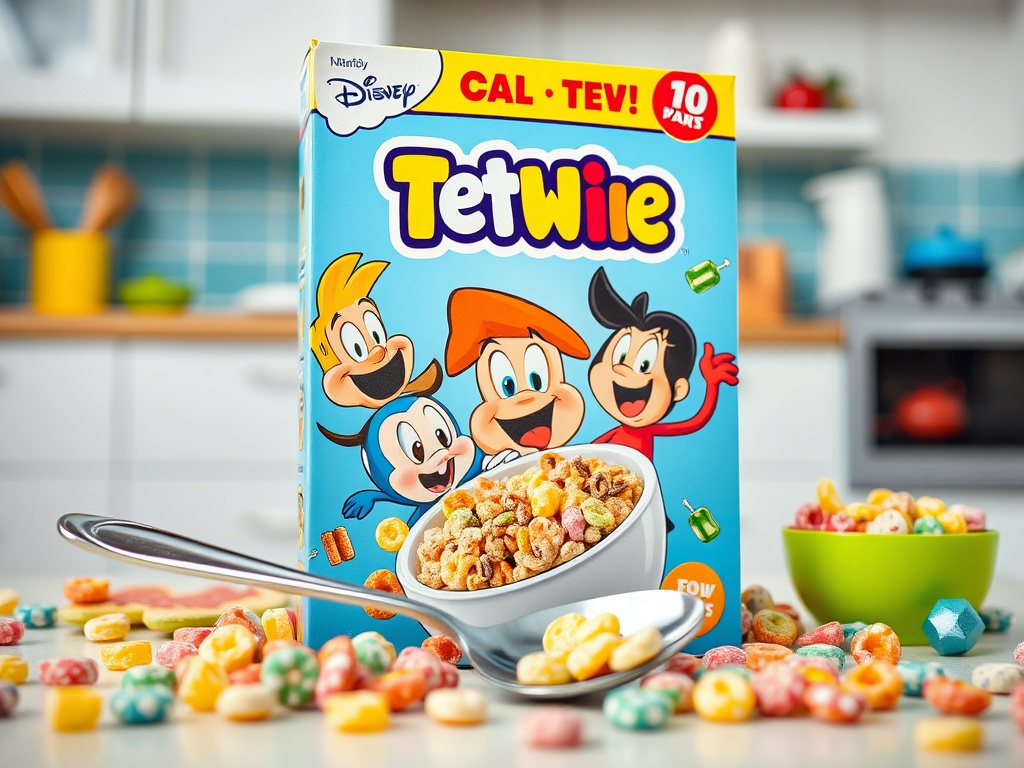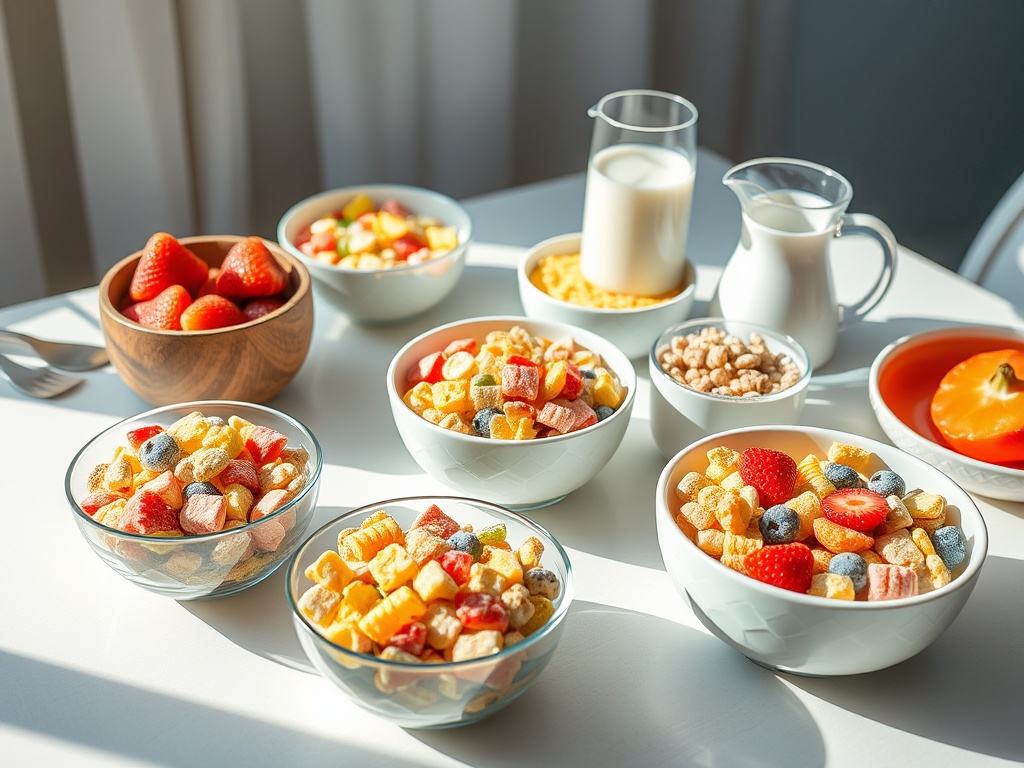The Breakfast Dilemma: Are Sugary Cereals Really a Good Start for Kids?
My 12-year-old son, Felix, eagerly pours himself a second helping of Lion cereal, a sweet blend of chocolate and caramel inspired by Nestlé’s popular confectionery bar. “I got the milk-to-cereal ratio wrong,” he insists, as I raise my eyebrow at his overflowing bowl. Meanwhile, his 14-year-old sister, Rosie, grabs the box and digs in. “It doesn’t taste overly unhealthy,” she remarks, mouth full, “but it probably is.”
She’s spot on. A 30g serving of Lion contains a staggering 7.3g of sugar, which accounts for nearly a quarter of the recommended daily sugar intake of 30g for children aged 11 and older. I challenge any parent to convince their tweens and teens to stop at just one serving.
Lion, along with KitKat, another sugary cereal offshoot from Nestlé, is hard to miss in local supermarkets. While these cereals are not specifically marketed to children, their appeal to my kids is undeniable.
But should these products even occupy space in the breakfast aisle? Dr. Alex Richardson, founder of Food and Behaviour Research, a charitable organization exploring the relationship between food and mental health, asserts, “There’s no way that feeding your children sweets, which is effectively what these cereals are, is a good way to start the day.”
Unfortunately, these sugary cereals are not alone in failing to meet our children’s health needs. Antonia’s children, like many others, are understandably attracted to these enticing breakfast options, often consuming bowl after bowl.
According to last month’s Broken Plate Report by The Food Foundation, only 3% of breakfast cereals aimed at children are classified as low in sugar (5g or less per 100g), a drop from 7% in previous years, marking a concerning trend. Despite growing awareness surrounding the need to combat childhood obesity, supermarkets are still selling these sugary cereals with alarming frequency. For instance, my local Morrisons offers children a free piece of fruit with each visit, yet when it comes to breakfast options, we seem to have a collective blind spot.
Market Trends and Misleading Claims
The breakfast cereal market, worth £1.7 billion annually, is seeing a decline, likely due to an increasing shift toward healthier eating and the growing preference for on-the-go meals. Nevertheless, children’s breakfast cereals remain the largest segment, valued at approximately £474 million. Their convenience and affordability make them appealing, allowing parents to send their kids off to school with the assurance that they’ve consumed something.
Many cereal boxes boast illustrations of wholesome grains, accompanied by claims of “wholegrain health” and promises of added vitamins and iron. So, how bad can they really be? Dr. Kawther Hashem, Head of Research and Impact at Action on Sugar, points out that while companies highlight the presence of essential micro-nutrients in their cereals, they often mask the fact that these products can contain up to 50% of a child’s daily sugar intake.
Dr. Richardson goes further, emphasizing that sugary cereals are among the worst ways to start the day. The impact extends beyond physical health; these cereals can cause early morning blood sugar spikes followed by crashes, resulting in the release of stress hormones like adrenaline and cortisol. This can severely disrupt a child’s focus and mood, making it difficult for them to sit still and concentrate in class.
Efforts have been made to address the sugar content in cereals. In 2016, the government introduced a voluntary “sugar reduction scheme” to encourage manufacturers to reformulate their products. For instance, Kellogg’s reduced the sugar in Coco Pops by 50% and Rice Krispies by 20%. A representative from Kellogg’s parent company, Kellanova, stated that they have successfully reduced sugar and salt by over a third across their children’s cereal range, claiming that none of these products now fall under the category of high sugar, salt, or fat according to government guidelines.
Meanwhile, Nestlé maintains that while some of its cereals are designed to cater to consumers seeking an occasional indulgent breakfast, over 80% of its cereal sales come from non-HFSS (high in fat, salt, and sugar) products like Shreddies and Shredded Wheat. They proudly announced that they have eliminated 516 million teaspoons of sugar from their portfolio between 2010 and 2020 as part of their long-term commitment to enhancing the nutritional value of their cereals.
However, in such a competitive marketplace, manufacturers must find clever ways to keep consumers purchasing. In 2023, Nestlé introduced KitKat cereal, which contains 7.4g of sugar per 30g serving. Dr. Hashem observes, “In recent years, we’ve seen many sugary products rebranded as breakfast foods, which are essentially confectionery disguised as cereals. It’s absurd that they can include vitamins and minerals and still market these as suitable breakfast options.”
In a bid to curb the promotion of unhealthy foods, government regulations now prevent high-sugar cereals from being advertised in prominent supermarket areas, such as checkouts and entrances. Yet, I notice that Kellogg’s has a sizable promotional display of Crunchy Nut cereal (11g sugar per 30g bowl) prominently placed in my local Morrisons foyer.
Starting in October, breakfast cereals will fall under the government’s ban on HFSS television advertising before 9 PM. However, there are still no restrictions on the use of animated characters and cartoon figures—think Frosties’ Tony the Tiger or Coco the Monkey—to market these cereals. A recent report from Action on Sugar revealed that 47% of cereals and yogurts aimed at children contain a third of the daily sugar allowance for a four-to-six-year-old. When I visit local supermarkets, it’s the unhealthiest options with garish packaging that stand out the most.
“Why don’t we see that kind of marketing for healthier options like porridge?” Dr. Hashem asks. “All chocolate-based cereals should be shelved in the chocolate aisle. They should be treated as snacks rather than breakfast foods.”
Certainly, Kellogg’s Krave, filled with chocolate (7.5g sugar per 100g), seems more akin to a sweet treat than a balanced breakfast. Likewise, Allegro’s Oreo O’s appeal to my son due to his fondness for the American cookie they are based on. “When my kids accompany me to the supermarket, that’s exactly what they gravitate toward,” agrees nutritionist Laura Southern, mother to a 15-year-old, a 13-year-old, and a seven-year-old. “While few of us would think to eat a KitKat for breakfast, the moment it’s presented in cereal form by a trusted brand, we assume it’s acceptable.”
Dr. Richardson advocates for a tax on added sugar in cereals and other foods, similar to the levy imposed on soft drinks in 2016. She insists that the government needs to take more action to limit our sugar consumption instead of yielding to pressure from large food corporations. “You never see advertisements for omelettes or other healthy breakfast options,” she points out. Eggs, in her opinion, make an excellent quick breakfast choice. “Starting each day with protein helps control your blood sugar,” she advises. Other nutritious options include cheese on wholegrain toast or a classic continental breakfast featuring cheese, fish, or cold cuts paired with salad. If your children do opt for cereal, she recommends choosing wholegrain varieties that retain their fiber, such as Shredded Wheat or All Bran.
Southern prepares a mix of sugar-free and regular puffed oats from Rude Health, alongside porridge garnished with seeds and Crunchy Nut Cornflakes as an occasional treat. Not all cereals are inherently unhealthy, however. Dr. Frederica Amati, a scientist and nutritionist, recently identified Weetabix as one of the better options available: “Technically it’s an ultra-processed food, but it contains fewer additives and is rich in fiber—a nutrient that most of us are lacking.”
Dr. Hashem offers her young children supermarket equivalents of Weetabix and plain porridge with milk, encouraging parents to select low-sugar options whenever feasible. Yet, she understands the challenges parents face amid time constraints and the relentless pressure from children to choose sugary cereals. “It’s incredibly difficult to navigate the marketing claims and the colorful packaging,” she admits. “You want to believe it’s safe for your child.”
Which Cereals to Choose or Avoid?

By nutritionist Laura Southern, founder of londonfoodtherapy.com
Nestlé KitKat
24.7g sugar per 100g
They say: “The delicious taste of chocolate & wafer, now for breakfast.”
Southern says: The depiction of a grain of wheat on the box misleadingly implies healthiness. The sugar content is alarming—one small bowl contains one-third of the daily sugar allowance for a 10-year-old. Additionally, ingredients such as emulsifiers have been associated with poor gut health and a heightened risk of diabetes.
Nestlé Shreddies
12.5g sugar per 100g
They say: “Unlock your morning energy.”
Southern says: While these are high in fiber due to their wholegrain wheat base, Shreddies contain sugar as their second, third, and fourth ingredients, including invert sugar syrup and barley malt extract, which are all different forms of sugar. The added B Vitamins and iron are synthetic and less likely to be absorbed by the body compared to those found in whole foods.
Mondelez Oreo O’s
27g sugar per 100g
They say: “Start your day with a playful twist.”
Southern says: This cereal is more akin to eating candy for breakfast. It has the highest sugar content among these cereals and primarily consists of refined white flour, which is lower in fiber compared to similarly sugary options.
Weetabix
4.2g sugar per 100g
They say: “There’s no better way to start your day!”
Southern says: The lowest in sugar and one of the healthiest cereals available. However, I would advise against serving Weetabix every morning, especially if your child consumes sandwiches and pasta for lunch and dinner. Too much gluten from wheat can be harsh on the gut and does not contribute to a varied diet.
Nestlé Cheerios
17.7g sugar per 100g
They say: “Brings a good balance of nutrition and taste to your family’s breakfast table.”
Southern says: Cheerios are a higher fiber option due to their combination of oat, wheat, and barley flour, though they still rely on three different types of sugar to maintain their shape.
Kellogg’s Rice Krispies
7.9g sugar per 100g
They say: “Made with natural grains and added goodness.”
Southern says: Rice Krispies are relatively low in sugar and not overly processed, but they also lack fiber, which is essential for stabilizing blood sugar levels.
Kellogg’s Cornflakes
8g sugar per 100g
They say: “Natural grains. Added goodness. No artificial colors or flavors.”
Southern says: Cornflakes provide a different type of fiber since they are made from maize rather than wheat, supporting gut health. The minimal ingredients make them a less processed choice. Additionally, some supermarket own-brand alternatives contain less sugar than Kellogg’s Cornflakes, so it’s worth comparing options.




